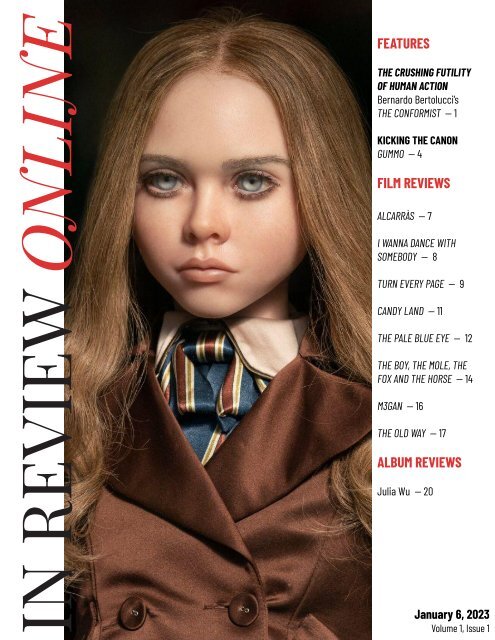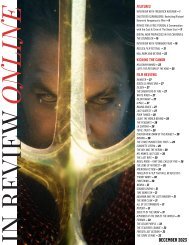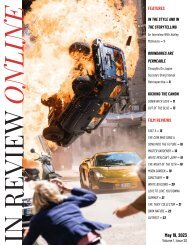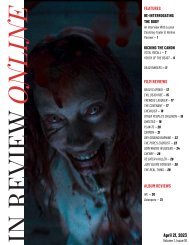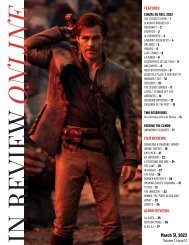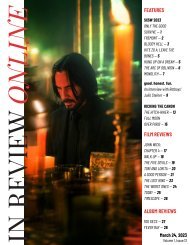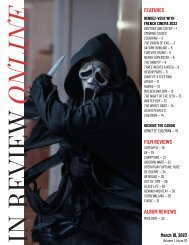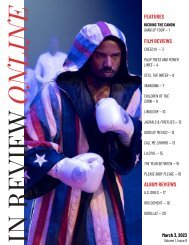InRO Weekly — Volume 1, Issue 1
Create successful ePaper yourself
Turn your PDF publications into a flip-book with our unique Google optimized e-Paper software.
THE CRUSHING FUTILITY<br />
OF HUMAN ACTION<br />
BERNARDO BERTOLUCCI’S<br />
THE CONFORMIST<br />
[A new 4K<br />
restoration of<br />
Bernardo Bertolucci’s<br />
The Conformist is playing<br />
at Film Forum January 6-19.]<br />
The '60s and '70s were a highly politically-charged time for Italian<br />
cinema. The country's neorealism movement chronicled working class<br />
lives in a post-WWII Italy <strong>—</strong> a newly post-fascist society still reeling from the<br />
fallout of the deadliest, most devastating conflict in human history. But unlike<br />
these grounded proletarian dramas, films like Ettore Scola's A Special Day, Lina<br />
Wertmüller's Seven Beauties, and most infamously Pier Paolo Pasolini's hellish Salò,<br />
or the 120 Days of Sodom confronted the nation's fascist past directly and in subversive,<br />
often highly controversial ways. Bernardo Bertolucci's luscious political thriller The<br />
Conformist, meanwhile, rendered the grim realities of fascism in ways none of his<br />
contemporaries did: alluring, hazy, anxious, and rife with repressed sexuality.<br />
1
Adapted from Alberto Moravia's 1951 novel of the same name, the film is, in essence, a character study of an easily persuadable yet<br />
deeply conflicted and profoundly disaffected also-ran named Marcello Clerici (played with remarkable complexity by Jean-Louis<br />
Trintignant). After a childhood marred by neglect, dysfunction, and a traumatic episode of sexual abuse, Marcello yearns for a "normal"<br />
life in an Italy that has fallen to fascism. His beliefs may not run deep, but his commitment does, and he goes through the motions of<br />
assimilating into fascist society <strong>—</strong> impassive church confessions where he comes clean about all manner of sin, an unenthusiastic<br />
marriage to a petit bourgeois putz, conscientious service for the fascist secret police <strong>—</strong> before being sent to Paris to assassinate his<br />
exiled former professor, Luca Quadri (Enzo Tarascio). Since fleeing Italy, Quadri has partaken in anti-fascist activities, and the Italian<br />
authorities believe they need to make an example of him. True to form, Marcello decides to take his wife along so he can get his<br />
honeymoon over with as well, but once they arrive, he soon begins an affair with Quadri's young wife, Anna (Dominique Sanda), who,<br />
upon learning of his motives, openly criticizes his allegiance to fascism, begging him not to hurt her and her husband.<br />
Sitting in a car on his way to finally finish the job for which he was sent to France, Marcello ponders his life and the circumstances<br />
that put him where he is. Bertolucci presents these memories with a subtle, dreamlike haziness that is emphasized by fluid camera<br />
movements and a vibrant, high-contrast color scheme. Even though its visuals have earned particular praise, The Conformist<br />
functions as a kind of Gesamtkunstwerk: image, sound, editing, script, and performance all combine into something transcendently<br />
cinematic. Shot by legendary cinematographer Vittorio Storaro, the film frames its characters against the cold, imposing architectural<br />
Rationalism popular under Mussolini's rule <strong>—</strong> in particular, the marble-benched asylum which houses Marcello's<br />
2
father, Antonio (Giuseppe Addobbati), stands out for its<br />
modernist harshness <strong>—</strong> and contrasts the latter with<br />
middle-class drawing rooms and the bohemian cafés of Paris.<br />
It's noteworthy that The Conformist still manages to shock with<br />
its depictions of sexual pathology, given that, aside from Salò,<br />
the era also saw the release of Tinto Brass's 1976<br />
proto-Nazisploitation erotic drama Salon Kitty and Luchino<br />
Visconti's sexually frank 1969 film, The Damned. Bertolucci would<br />
further explore themes of sexuality with the controversial Last<br />
Tango in Paris, but with The Conformist, he opted explicitly to link<br />
sexual repression with the ideology of fascism. Far from the first<br />
(or last) work to do so, the film's take nevertheless proves<br />
uniquely tragic, as the story not only highlights the depths of its<br />
main character's pathetic ennui, but also the crushing futility of<br />
human action: in spite of his best efforts, Marcello's obsessive<br />
conformism proves to be in vain when Mussolini resigns as head<br />
of state and the rubble-filled streets are overrun by celebrating<br />
anti-fascists. Worse, he learns that perhaps the most pivotal<br />
moment of his life, his supposed murder of childhood abuser<br />
Lino (Pierre Clémenti), didn't actually happen as he thought it did,<br />
as he finds Lino, now balding and gray, sitting in a dark alley,<br />
again attempting to seduce a young boy.<br />
Marcello isn't the only one who lives his life in the shadow of<br />
sexual abuse, though. On the train to Paris, his wife Giulia<br />
(Stefania Sandrelli) relays a story of how she lost her virginity at<br />
15 to a 60-year-old family friend <strong>—</strong> a man she used to call uncle.<br />
Aroused, Marcello begins undressing her while asking whether or<br />
not she liked the encounter. The score swells romantically as the<br />
couple are consumed by the lust her memory has roused in them,<br />
the warm, red sky outside paradoxically transforming into a<br />
muted, cool blue. The film also hints at some element of<br />
impropriety in the relationship between Marcello and his<br />
morphine-addicted mother (Carla Mignone, better known by her<br />
stage name Milly), although Bertolucci wouldn't explore the<br />
subject of mother-son incest in depth until 1979's La Luna, a<br />
drama that Soviet filmmaker Andrei Tarkovsky described as<br />
"monstrous, cheap, vulgar rubbish" in a diary entry.<br />
“… functions as a kind of<br />
Gesamtkunstwerk: image,<br />
sound, editing, script, and<br />
performance all combine into<br />
something transcendently<br />
cinematic.<br />
In spite of its grave subject matter, The Conformist manages to<br />
portray both the dark and light sides of passive conformity, such<br />
as when a meeting between Marcello and a high-ranking member<br />
of the secret police concludes with Marcello absentmindedly<br />
pointing a gun at his superior before nonchalantly noticing that<br />
he must have misplaced his fedora. Similarly, the form bounces<br />
from uninterrupted camera glides to the skewed, claustrophobic<br />
angles of film noir, and by the time the fascist henchmen emerge<br />
like specters from the foggy woods to dispose of the<br />
troublesome Quadris, the ensuing burst of violence <strong>—</strong> not to<br />
mention the sheer terror in Anna's eyes as she realizes Marcello's<br />
betrayal <strong>—</strong> as refracted in the titular conformist's detached gaze,<br />
scans as nothing short of sociopathic. His conscience has been<br />
extinguished by his desire to fit in, an utterly pointless<br />
transformation as he will come to realize just a few years later<br />
when the end of the Duce's reign is announced on the radio. And<br />
when he finally sits down during the final moments, he fixes his<br />
eyes on the audience; his guilt, regret, and confusion becoming<br />
truly tangible for the first (and last) time. <strong>—</strong> FRED BARRETT<br />
3
2
KICKING THE CANON<br />
Korine's unflinching artistic instincts were apparent when Larry<br />
Clark adapted his screenplay for Kids in 1995. The New York City<br />
tale of youthful depravity shocked and intrigued audiences with<br />
its loose storytelling form and frank depictions of sex and drug<br />
abuse, but with Gummo, the then-24-year-old former<br />
skateboarder decided to do away with narrative entirely. In an<br />
interview with fellow director Werner Herzog <strong>—</strong> both a fan of and<br />
a major influence on the young filmmaker <strong>—</strong> Korine had this to<br />
say about the state of film in the mid-to-late '90s: "When I look at<br />
the history of film […] and then look at where films are now, I see<br />
so little progression in the way they are made and presented, and<br />
I'm bored with that [...] With Gummo I wanted to create a new<br />
viewing experience with images coming from all directions." His<br />
dissatisfaction with the medium's creative stagnation is felt in<br />
the feverishness of the film's audiovisual assault, a formal<br />
“<br />
Gummo<br />
approach where every frame is overloaded with information.<br />
remains [Korine’s] purest artistic<br />
statement, the epicenter of all of his creative<br />
endeavors, the fount from which every<br />
other work in his oeuvre springs.<br />
Revisiting the film 25 years later, Gummo not only retains every<br />
bit of its darkly enticing appeal, but it also makes clear Korine's<br />
status as a genuine cultural force. Although he was, and<br />
sometimes still is, dismissed as a cheap provocateur <strong>—</strong> Maslin<br />
wasn't the only critic who was less than impressed with what he<br />
had to offer <strong>—</strong> his profound influence on contemporary pop<br />
aesthetics cannot be overstated. Another admirer of Korine's, Gus<br />
Van Sant, praised the film's "sophisticated and refined cinematic<br />
dialogue of modern cultural influences." This cinematic dialogue<br />
has cast a long shadow <strong>—</strong> as the film's cat-killing main<br />
characters Solomon (Jacob Reynolds) and Tummler (Nick Sutton)<br />
ride their bikes down a hill, looking for prey, the scene is<br />
accompanied by the thunderous stoner metal riff of Sleep's<br />
"Dragonaut," and the bizarre underclass Americana that the short<br />
vignette evokes has retained so much of its aesthetic<br />
staying power that, more than two decades later, it's easy to<br />
picture a similar scene playing out to the sinister trap sounds of<br />
Migos or Kodak Black in an episode of Atlanta, or couched within<br />
the upside-down-cross pranksterism of an early Odd Future<br />
music video.<br />
While Korine's acute awareness of the zeitgeist would eventually<br />
lead him to godfather the Tampa-core genre with his oneiric<br />
black comedy crime thriller Spring Breakers, Gummo remains his<br />
purest artistic statement, the epicenter of all of his creative<br />
endeavors, the fount from which every other work in his oeuvre<br />
springs. The Dogme 95 drama Julien Donkey-Boy, the low-rent<br />
scuzzfest Trash Humpers, and the melancholy outsider dramedy<br />
Mister Lonely all boast DNA that can be traced back to Korine’s<br />
first film. Even his absurdist novel, A Crack Up at the Race Riots <strong>—</strong><br />
an attempt at "the Great American Choose Your Own<br />
Adventure Novel" <strong>—</strong> trades in the same bleak, fragmented,<br />
quasi-comedy of Gummo. In his interview with Herzog, Korine<br />
elaborates: "It goes back to [Charles and Ray] Eames and<br />
[Isamu] Noguchi talking about a unified aesthetic. You can make<br />
movies, write books, do a ballet, and sing opera, but it's all part of<br />
the same vision."<br />
There’s a crucial piece that the director's lesser imitators, critical<br />
naysayers, and quite a few ignorant fans miss, however: in spite<br />
of the depravity it depicts, in spite of the borderline exploitative<br />
relationship it itself has with its subjects, there is a quiet<br />
tenderness to Gummo that exists alongside the nihilistic<br />
radicalism that permeates it. Korine isn't interested in shocking<br />
the audience as much as he's trying to place them squarely in a<br />
milieu that they (most likely) know nothing about. And yet, the<br />
5
KICKING THE CANON<br />
famous scene of Solomon eating spaghetti and drinking milk in a bathtub filled with filthy, brown water resonates exactly because of<br />
how familiar and mundane it feels <strong>—</strong> a young boy sitting in a dirty bathtub, messily eating his dinner, while his mother tries to get him<br />
clean. It's decidedly odd <strong>—</strong> for some reason, a strip of fried bacon is taped to the bathroom wall <strong>—</strong> and it's slightly uncomfortable, but<br />
seen through Korine's eyes, the scene also becomes strangely touching, a snapshot of normalcy amidst a world that has been thrown<br />
into disarray. It confronts us with the fact that the people we tend to look down on are, in fact, human beings, too <strong>—</strong> maybe that's<br />
where the crux of Korine's provocation truly lies. <strong>—</strong> FRED BARRETT<br />
6
FILM REVIEWS<br />
ALCARRÀS<br />
Carla Simón<br />
From the first frame of Alcarràs, Carla Simón alerts the viewer to<br />
the integrality of the summery Catalonian landscape of her film.<br />
Within these windswept fields and misshapen buttes resides the<br />
Solé family, modest peach farmers <strong>—</strong> partially based on the<br />
director’s own family <strong>—</strong> and played by a rugged cast of<br />
nonprofessionals. The vantage point of childhood often mingles<br />
with realism in Simón’s work, with the still-present undercurrents<br />
of the aftermath of the Spanish Civil War lending a subtle<br />
historicity. Alcarràs hinges on the Solé family being evicted from<br />
their peach farm, which was given to them as a reward from the<br />
wealthy Pinyol clan, after offering their protection during the<br />
war; these sorts of displays of gratitude, enacted through any<br />
formal paperwork, are unfortunately archaic in the film’s present<br />
day.<br />
The conflict, however earth-shattering it may read, is also<br />
somewhat ancillary, encouraging the viewer to map out the ebb<br />
and flow of relationships of this extended family rather than<br />
anticipate their final displacement. Modernity has its harbinger<br />
in an unwelcome, monstrous tractor crane in the opening shots<br />
<strong>—</strong> interrupting the play of the smaller children, whose reaction<br />
shots from behind a car’s windshield seal the Lucrecia Martel<br />
influence then and there <strong>—</strong> but work still has to continue,<br />
regardless of encroaching industrialization and the threat of<br />
deposition. The arbiters of change offer an alternative, and even<br />
if it is lucrative, it doesn’t account for the loss of an<br />
intergenerational home.<br />
The eviction is sinuous; it doesn’t buffet the family as much as it<br />
lies in wait. So in the meantime, Simón catalogs and files the<br />
quotidian activities of a peach farm maintained by the various<br />
generations of a single family. Daniel Cajítas’ camera often<br />
begins at the center of a permutation of the ensemble, before<br />
casually attaching itself to a certain party, the latent isolation<br />
registered by quiet observation of larger events. More than once,<br />
teenagers, children, and the elderly will make their way out to the<br />
crop, standing alone amidst what’s provided for them for so long,<br />
and what may be soon repossessed. In some ways, Alcarràs<br />
resembles Olivier Assayas’ Summer Hours, or at least a proletariat<br />
transposition, especially in the party scene near the end, where<br />
7
FILM REVIEWS<br />
focus is equally dispensed amongst all participants. The Solés<br />
live with the very reminder of what they may lose, a rather<br />
poignant development, which is what makes the most relaxed of<br />
scenes also the most enjoyable, and meaningful; they convey all<br />
that the verbal disputations can’t.<br />
However, the demands of contemporaneous realism trip up the<br />
more patient <strong>—</strong> even spiritual <strong>—</strong> pastoralism of Alcarràs. The<br />
rapport of the extended family is as warm as it is believably<br />
strained, so a few of Simón’s efforts to delineate the variety of<br />
viewpoints are unfortunately redundant, rendering characters as<br />
brief stock-types, especially the brother-in-law who tries to<br />
ingratiate himself into the Pinyols. The director’s own narrative<br />
motivations sit uneasily atop those of the characters; these are<br />
the intervals where the film, purporting to be of a documentary<br />
quality, comes off as unbearably written. But then there’s the<br />
closing shot, an image of such unceremonious perfection, and<br />
the fitful heaviness of the directorial hand is, at least to some<br />
degree, justified. <strong>—</strong> PATRICK PREZIOSI<br />
DIRECTOR: Carla Simón CAST: Jordi Pujol Dolcet, Anna Otin,<br />
Xenia Roset, Albert Bosch, Berta Pipó DISTRIBUTOR: MUBI IN<br />
THEATERS: January 6 RUNTIME: 2 hr. 0 min.<br />
I WANNA DANCE WITH SOMEBODY<br />
Kasi Lemmons<br />
When Kasi Lemmons made her directorial debut with the 1997<br />
Southern Gothic masterpiece Eve's Bayou, it likely wouldn't have<br />
occurred to people that she would eventually be reduced to<br />
working on by-the-numbers fare like I Wanna Dance with<br />
Somebody, the latest cinematic equivalent of a Wikipedia article<br />
<strong>—</strong> this one based on the life of Whitney Houston. Lemmons's film,<br />
adapted from a script by Bohemian Rhapsody screenwriter<br />
Anthony McCarten, is a slipshod attempt at cleaning up the<br />
legendary songstress' image and legacy, all while scrubbing away<br />
the messier aspects of her humanity. As such, even I Wanna<br />
Dance with Somebody's decision to not focus on Houston's<br />
scandal-ridden later years feels cynical, a transparent effort by<br />
her estate, which participated in the project, not to rehabilitate<br />
her as much as make her marketable again <strong>—</strong> a process which is<br />
already in motion, with a line of cosmetics and a variety of Funko<br />
POP! Figurines.<br />
It's unfortunate, but the rote filmmaking on display here couldn't<br />
be further removed from the layered sensitivity that has marked<br />
Lemmons's previous work <strong>—</strong> even her somewhat formulaic 2019<br />
Harriet Tubman biopic Harriet drew out some memorable<br />
performances from its cast. I Wanna Dance, by contrast, plays<br />
more like a glorified clip show where none of the actors are given<br />
room to breathe. Naomi Ackie manages to wring a surprising<br />
amount of depth out of the clichéd material, but her co-stars,<br />
including Stanley Tucci and the woefully underemployed Ashton<br />
Sanders, are completely suffocated under a barrage of shoddily<br />
conceived and assembled scenes, filled with tropes that would<br />
have felt stale a decade ago.<br />
The film opens at the 1994 American Music Awards, where<br />
Whitney Houston (Ackie) is preparing to deliver her famous<br />
medley of "I Loves You, Porgy," "And I Am Telling You I'm Not<br />
Going," and "I Have Nothing," obviously setting up what will come<br />
to represent the peak of her musical career <strong>—</strong> her own 1985 Live<br />
Aid moment, so to speak. After the title card, the audience is<br />
taken to 1983, where a young Whitney dazzles a New Jersey<br />
church congregation with her raw vocal talent. Led with a firm<br />
but loving hand by her mother, Cissy Houston (Tamara Tunie) <strong>—</strong><br />
an accomplished singer in her own right <strong>—</strong> Whitney eventually<br />
manages to secure a record deal after her extraordinary<br />
performance of George Benson's "The Greatest Love of All"<br />
impresses record producer Clive Davis (Stanley Tucci). However,<br />
the ensuing success proves difficult to navigate, and Whitney is<br />
forced to contend with accusations of selling out, her<br />
overbearing father John (Clarke Peters), who also works as her<br />
manager, and a strained and abusive marriage to R&B singer<br />
Bobby Brown (Ashton Sanders).<br />
Much like he did with Freddie Mercury <strong>—</strong> Bohemian Rhapsody<br />
played down the Queen frontman's queerness in favor of a more<br />
8
FILM REVIEWS<br />
flattering portrayal of the surviving band members, another<br />
example of an estate working to protect its own bottom line <strong>—</strong><br />
McCarten here flattens Houston into an uncomplicated, easily<br />
digestible avatar, and as such, her same-sex relationship early in<br />
life, as well as her internalized homophobia, are included but<br />
insufficiently explored. Similarly, her spiritual development <strong>—</strong><br />
admittedly unhip subject matter that few contemporary<br />
filmmakers are willing to engage with <strong>—</strong> is barely given the time<br />
of day, in spite of her having been brought up in the church and<br />
the film’s penchant for asking characters to use the Bible to<br />
rationalize their behavior. Instead, we get predictable gestures,<br />
transparently designed to appeal to modern sensibilities: "Yes,<br />
I'm exhausted. All Black women are exhausted," complains<br />
Houston in a particularly unnatural exchange.<br />
While I Wanna Dance's hagiographic treatment mostly relies on<br />
the power of the music (or, more specifically, its subject's<br />
soaring voice) to generate its few captivating moments, it fails to<br />
truly capture the transcendent beauty that made Houston's<br />
legendary melisma such an enduring part of popular culture. The<br />
singer's legacy needed a corrective after years of being defined<br />
by her premature, drug-related death, and regardless of<br />
whatever financial motivations led to it, the choice to ultimately<br />
not frame her life as mere tragedy, particularly given the genre,<br />
is indeed commendable. But it's hardly an excuse for crafting a<br />
film that is ultimately this lifeless and dull. <strong>—</strong> FRED BARRETT<br />
DIRECTOR: Kasi Lemmons CAST: Naomi Ackie, Ashton Sanders,<br />
Stanley Tucci, Tamara Tunie, Clarke Peters DISTRIBUTOR: Sony<br />
Pictures IN THEATERS: December 23 RUNTIME: 2 hr. 26 min.<br />
TURN EVERY PAGE: THE ADVENTURES OF<br />
ROBERT CARO AND ROBERT GOTTLIEB<br />
Lizzie Gottlieb<br />
What makes a great writer? Romantics and bookworms might<br />
wax poetic about unparalleled emotional insight or the fearless<br />
plumbing of the human condition, but pragmatists (and<br />
publishers) know the real answer: the secret to a great writer is a<br />
great editor. Lizzie Gottlieb’s documentary Turn Every Page: The<br />
Adventures of Robert Caro and Robert Gottlieb focuses on the<br />
50-year editorial relationship between two giants of 20th-century<br />
letters: Caro, deemed “the greatest political writer and thinker of<br />
our time” by his publisher, and his editor Gottlieb,<br />
9
FILM REVIEWS<br />
panic mode. As someone who moved home after college partly to<br />
sustain an unpaid publishing internship <strong>—</strong> which never turned<br />
into a full-time job <strong>—</strong> I viewed much of Gottlieb’s archival footage<br />
with a certain (perhaps unwarranted) wistfulness. Here are but<br />
two bespeckled white dudes arguing about semicolons in a<br />
book-lined conference room, and not a federal antitrust lawsuit,<br />
employee walkout, or paywall in sight. Ah, those were the days.<br />
the luminary who, among other achievements, convinced Joseph<br />
Heller to swap out “18” with “22” in the title of his most famous<br />
book. As Gottlieb’s daughter, Lizzie has enviable access to both<br />
men, as well as a host of other literary titans, industry insiders,<br />
Caro superfans, and a couple of former Presidents to share in<br />
the memories of its two octogenarian subjects.<br />
After quick biographical sketches <strong>—</strong> Caro’s unhappy childhood,<br />
Gottlieb’s unabashed nerdiness <strong>—</strong> the documentary settles into a<br />
pleasantly unobtrusive yet instructive rhythm. In addition to its<br />
central relationship, Turn Every Page is part New York City history<br />
as told through Caro’s biography of its massively influential and<br />
divisive master builder, Robert Moses, and part 20th-century<br />
American history as told through his multi-volume biography of<br />
President Lyndon B. Johnson. It’s also a slightly rose-tinted<br />
chronicle of the golden age of print media. Both men started<br />
their careers in the 1960s, long before the Internet’s slurry of free<br />
and endless content sent the publishing industry into prolonged<br />
An unelected city planner might not seem like the natural subject<br />
for a 1,300-page doorstop, but no matter: like Infinite Jest, just<br />
having The Power Broker on your shelf, no matter how dusty,<br />
oozes intellectual pedigree. No one actually expects you to read<br />
it (I myself live with two city planners, and I’ve only ever seen the<br />
book used as a laptop stand.) But for its many fans <strong>—</strong> it is<br />
currently in its 41st continuous printing <strong>—</strong> The Power Broker both<br />
cemented Caro’s genius and set the stage for his next<br />
multi-decade undertaking: an as-yet-unfinished five-part<br />
biography of President Lyndon B. Johnson, who wielded immense<br />
political power in profoundly contradictory ways. And every step<br />
of the way, Robert Gottlieb was there with his No. 2 pencil (never<br />
mechanical!) to wrangle, wrassle, and chisel Caro’s manuscripts<br />
into masterpieces. As he wryly states early in the documentary,<br />
“He does the work, I do the cleanup. Then we fight.” If all editorial<br />
relationships were twice as adversarial but even half as fruitful,<br />
publishing executives might have cause to finally stop<br />
hand-wringing (and maybe even raise wages.)<br />
The timing of Turn Every Page is fortuitous, and not just because<br />
its subjects are rapidly aging and Caro is still industriously<br />
plugging away at Now! That’s What I Call LBJ. The past few years<br />
have enjoyed a renewed popular interest in urbanism as a whole,<br />
with the pandemic sparking national conversations about the<br />
role of urban spaces post-lockdown; suddenly, it seemed like all<br />
the cool kids were discussing Jace Jacobs over their sourdough<br />
starters. This interest hasn’t abated: 2022 saw the debut of<br />
Straight Line Crazy, starring Ralph Fiennes as Robert Moses (a<br />
canny bit of casting for someone who’s often viewed as the<br />
Voldemort of modern cityscapes). And given the global political<br />
and cultural slide toward authoritarianism, Caro’s stated goal <strong>—</strong><br />
10
FILM REVIEWS<br />
to inform the public about democracy as it is, not as it should be,<br />
so they can vote accordingly <strong>—</strong> is more valuable than ever. For all<br />
our sakes, let’s keep the pencils sharpened, the archives dusted<br />
off, and the pages turning. <strong>—</strong> SELINA LEE<br />
DIRECTOR: Lizzie Gottlieb CAST: Robert A. Caro, Robert Gottlieb<br />
DISTRIBUTOR: Sony Pictures Classics IN THEATERS: December<br />
30 RUNTIME: 1 hr. 52 min.<br />
highlight of last year’s Ida Red being a random moment where<br />
Frank Grillo, clad in cowboy hat and mesh shirt, dances to Naked<br />
Eyes’ “Promises Promises” before brutally murdering a woman.<br />
Candy Land is that moment dialed to one hundred, a deep dive<br />
into depravity that is refreshing in its remorselessness. Indeed,<br />
this is a film that, within its first five minutes, features graphic<br />
sex, full-frontal nudity, and the tormenting of religious<br />
fundamentalists.<br />
CANDY LAND<br />
John Swab<br />
In only a few short years, writer-director John Swab has churned<br />
out a handful of low-budget features that have rarely risen above<br />
the mantle of mediocrity. Part of this seems like a direct result of<br />
attempting so much in so little time, for a filmmaker happy to be<br />
getting consistent work in today’s hellish filmmaking landscape.<br />
Yet those familiar with Swab’s filmography may find themselves<br />
going a tad easier on this particular director than many of his ilk,<br />
largely because it’s obvious that he’s in possession of true<br />
technical chops, with a genuine love of the medium ingratiating<br />
itself into every frame. If one were to be especially generous,<br />
they might see a little of the early Walter Hill in his work, a true<br />
legend who understood the supposed limitations of genre fare<br />
and exploited them to produce bracing works of bravado.<br />
“[This] callback to the<br />
grindhouse flicks of the ‘70s<br />
offers up the most respectful<br />
portrait of sex workers the<br />
big screen has seen in ages.<br />
Swab’s latest, Candy Land, eschews the crime drama framework<br />
so inherent to his other films and embraces pure exploitation,<br />
which ultimately frees the filmmaker to deliver his best and most<br />
accomplished work to date. Swab has always excelled when<br />
leaning into this particular texture in past projects, with the<br />
The titular location refers to the last exit on Route 66 before<br />
endless miles of nothingness, the type of low-down and dirty<br />
truck stop where travelers can grab both a meal and a piece of<br />
ass. It’s here where we meet our ragtag group of protagonists, a<br />
five-person squad of sex workers including house mother Nora<br />
(Guinevere Turner) and employees Sadie (Sam Quartin), Riley<br />
(Eden Brolin), Liv (Virginia Rand), and lone male Levi (Owen<br />
Campbell). Not long after, a newcomer <strong>—</strong> Remy (Olivia Luccardi),<br />
one of the aforementioned zealots who has seemingly<br />
abandoned the church to discover a newfound world of<br />
independence <strong>—</strong> enters this tight-knit clan. Unfortunately, she’s<br />
arrived at exactly the wrong moment, as a killer, whose identity<br />
is as obvious as it is inevitable, is targeting various clients of<br />
Candy Land.<br />
But make no mistake: Candy Land isn’t trying to pull the rug out<br />
from under its audience members; it establishes its central<br />
antagonist early in the game. Such a move simply reinforces the<br />
film’s exploitative roots, seen in every leering close-up of its<br />
female cast members’ naked bodies and its somehow lovingly<br />
shot moments of brutal violence. Indeed, Swab embraces these<br />
details in ways that put other such 21 st -century attempts to<br />
shame <strong>—</strong> those films that serve up so-called “exploitation” in the<br />
most sanitized and neutered fashion possible, obviously intended<br />
not to offend audience members in a bid for populist<br />
acceptance. Candy Land has no interest in such bullshit, offering<br />
up its tale of religious cleansing in the most overheated ways<br />
possible. Still, such a description fails to recognize the deep<br />
empathy Swab clearly feels for his characters, namely the<br />
individuals who call Candy Land home. It’s hard to believe that, in<br />
11
FILM REVIEWS<br />
2023, a callback to the grindhouse flicks of the ‘70s offers up the<br />
most respectful portrait of sex workers the big screen has seen<br />
in ages, and yet here we are.<br />
It also can’t be overstated just how great the film looks, each<br />
shot a tutorial in proper shot composition, with the occasional<br />
ajar door and rain-streaked car window proving as effective as<br />
the choice of shag carpeting seen at its end <strong>—</strong> which, pardon the<br />
expression, is quite simply chef’s kiss. This is only outdone by the<br />
choice of a needle drop, also approaching the denouement, so<br />
utterly perfect that Swab deserves credit for blowing his entire<br />
budget on simply obtaining its rights. Much like past Swab<br />
projects, the cast is uniformly terrific, which proves that the<br />
filmmaker is both a technician and an actor’s director, and that’s<br />
a rare combo in today’s climate. The lone name cast member,<br />
one Mr. William Baldwin, certainly seems thrilled to get<br />
down-and-dirty and earn a paycheck, but the fact that he is the<br />
weak link here seems less a factor of commitment and more a<br />
result of the level of wackadoo characterization he is forced to<br />
endure. Such a complaint, however, is one of the few this critic is<br />
going to lob at Candy Land, which kicks off 2023 on exactly the<br />
right foot; Team Swab starts right here. <strong>—</strong> STEVEN WARNER<br />
DIRECTOR: John Swab CAST: Olivia Luccardi, William Baldwin,<br />
Sam Quartin, Owen Campbell DISTRIBUTOR: Quiver Distribution<br />
IN THEATERS: January 6 RUNTIME: 1 hr. 33 min.<br />
THE PALE BLUE EYE<br />
Scott Cooper<br />
Based on Louis Bayard’s 2003 novel, Scott Cooper’s painfully dull<br />
The Pale Blue Eye imagines a fictional murder mystery featuring<br />
one Edgar Allan Poe (Harry Melling) assisting alleged master<br />
detective Augustus Landor (Christian Bale) in sleuthing around<br />
West Point (which Poe actually did attend). Someone’s strung up a<br />
cadet and cut out his heart, and for some reason Landor settles<br />
on Poe as someone who can help him navigate the ins and outs<br />
of both the Academy and the local gentry, while the famous<br />
author finds both fuel for his writing and a pretty girl in the<br />
course of the case.<br />
It’s an ostensibly intriguing idea to give us a moody, atmospheric<br />
mystery as the inspiration for some of fiction’s most famous<br />
works, but the film that Cooper delivers is instead inert,<br />
suspense-free, and so emotionally remote as to render any<br />
attempts at complexity or ambiguity completely unnoticeable.<br />
Even more puzzling is that the story would appear to have little to<br />
no bearing on Poe’s work at all; even though Melling is sufficiently<br />
convincing as a melancholic weirdo, one could swap Poe out here<br />
for literally anyone else, famous or not, and The Pale Blue Eye<br />
would remain the exact same film. Sure, there might be a few<br />
easter eggs to be found and some references to remind of Poe’s<br />
famous stories and poems, but they don’t<br />
12
FILM REVIEWS<br />
enhance the story or add any layers of cleverness or nuance to<br />
the bland proceedings.<br />
The mystery itself is both sluggish and fairly rote, even if it does<br />
revolve around heart removal and privileged secret societies that<br />
bloom into cults. Poe and Landor barely do any actual<br />
investigating, as most of the important clues, like a crucial<br />
journal or a crumpled note, for instance, simply fall into their<br />
laps. Meanwhile, the culprits <strong>—</strong> at least in the initial murder <strong>—</strong><br />
are pretty readily identifiable. You can only feature so many<br />
portentous bits of dialogue and clandestine shifty-eyed<br />
close-ups before one begins to tire of taking the hint. And that’s<br />
all doubly bizarre since the whole film is building to a ridiculous<br />
rug-pull ending that most viewers probably won’t see coming<br />
simply because it’s wildly illogical and narratively arbitrary,<br />
retroactively turning what started as a placid literary procedural<br />
into one of Cooper’s patented mopey revenge flicks.<br />
Indeed, the director’s usual brooding is as present as ever, but in<br />
truth it barely registers over the whispery performances and the<br />
grayed-out color palette, both of which contribute to the wasting<br />
of such resourceful actors as Robert Duvall as some wily old<br />
investigator, Timothy Spall as the conniving base commander,<br />
and a briefly amusing Gillian Anderson. Bale himself is fully on<br />
autopilot, imbuing Landor with exactly nothing but his usual dose<br />
of gruff and aloof masculinity. The character is a total blank,<br />
making the events of the third act all the more baffling and<br />
unsatisfying. You’d be better off watching the supremely goofy<br />
John Cusack-as-Poe film The Raven: that film is certainly one<br />
that time has forgotten, but The Pale Blue Eye is in fact the work<br />
that much more richly deserves to disappear into the dustbin of<br />
history. <strong>—</strong> MATT LYNCH<br />
DIRECTOR: Scott Cooper CAST: Christian Bale, Harry Melling,<br />
Gillian Anderson, Robert Duvall, Lucy Boynton DISTRIBUTOR:<br />
Netflix STREAMING: January 6 RUNTIME: 2 hr. 26 min.<br />
13<br />
12
FILM REVIEWS<br />
THE BOY, THE MOLE, THE FOX AND THE<br />
HORSE<br />
Charlie Mackesy, Peter Baynton<br />
The Boy, the Mole, the Fox and the Horse is quite naked in its<br />
ambitions to become the next classic British Christmas special <strong>—</strong><br />
The Snowman (1982) for a new generation. While Raymond Briggs’<br />
influence can be seen in both Charlie Mackesy’s book and the<br />
film adaptation he co-directed with Peter Baynton, he pinches<br />
much more liberally, and much more blatantly, from Winnie the<br />
Pooh: from the loose art style which (like E.H. Shepard) tries to<br />
retain the energy of underdrawing to the sentimental one-liners<br />
which don’t just borrow their rhythm from A.A. Milne, but their<br />
content too. The book’s second line, “[you’re so small] but you<br />
make a big difference,” reads suspiciously close to “sometimes,<br />
the smallest things take up the most room in your heart.”<br />
Suspicious beyond a reasonable doubt, some would say.<br />
pointing toward emotional caricature rather than any emotion in<br />
particular. Mackesy’s addition to the formula is this: instead of<br />
images, like a group of people or animals around a table or tree,<br />
he evokes emotion bluntly and directly through the little self-help<br />
quotes that solely populate the dialogue.<br />
What’s quite shocking is how untethered these warmed-over bits<br />
of “wisdom” are from any kind of story. Based on the<br />
accompanying documentary, however, this seems to be a point<br />
of pride for Mackesy; he insists that the story doesn’t need a<br />
narrative, that the story is the conversation. But for there to be a<br />
conversation, there must be characters to converse in it. These<br />
four are only thinly distinguished by a single trait <strong>—</strong> the Mole<br />
loves cake (in a way that’s reminiscent of a different character’s<br />
love of honey), and the Fox is drawn <strong>—</strong> and all speak in the exact<br />
same voice. Either way, they aren’t having a conversation;<br />
nothing is bridging one inspirational quote from the next, as they<br />
are simply stated without motivation or context. It’s hard to<br />
convey the extent of this, except to say that when reading the<br />
even looser book <strong>—</strong> which doesn’t even have the setup of being<br />
lost or the idea of some home to move toward <strong>—</strong> it’s easy to find<br />
yourself wondering if the pages might be in the wrong order.<br />
But The Boy, the Mole is best understood as part of a lineage of<br />
British Christmas adverts: specifically, the style brought in by the<br />
collaborations between the department store John Lewis and the<br />
advertising agency Adam & Eve, which started in the late 2000s<br />
but peaked throughout the 2010s as innumerable similar brands<br />
copied them, making ever so slight variations on the exact same<br />
thing. They are always faintly narrative <strong>—</strong> the Bear and the Hare<br />
in John Lewis’ 2013 ad centered around the vague idea of<br />
Christmas, just as the Boy, the Mole, and the others travel toward<br />
the vague idea of home <strong>—</strong> but are primarily driven by sentimental<br />
setpieces, created only from abstracted signifiers<br />
“The Boy, the Mole is best<br />
understood as part of a<br />
lineage of British Christmas<br />
adverts.<br />
It’s no surprise, then, to learn that this horrible enterprise began<br />
as Instagram posts. Little work has gone into adapting it into<br />
anything else for the movie <strong>—</strong> the book might as well be a bunch<br />
of random posts printed and stapled together. It’s hard not to<br />
wonder if Charlie Mackesy is just as cynical. The ads which his<br />
work most resembles frame themselves as non-commercial in<br />
that they never feature the brand or their products (though they<br />
do tend to feature a cuddly character who will no doubt be<br />
14
FILM REVIEWS<br />
available as a plush toy). Alongside the wacky adverts that just<br />
preceded them, like the Gorilla drumming along to Phil Collins’ In<br />
The Air Tonight for Cadbury, they are driving marketing further<br />
toward abstraction, moving away from the tropes that the<br />
general public are familiar with in order to smuggle their<br />
messages into their brains through other means, such as the<br />
false pretenses of quirkiness, sentimentality, or social cause. And<br />
so, despite how aggressively surface-level and thin Mackesy’s<br />
work seems to be, one has to ask what exactly it is that he’s<br />
trying to sell.<br />
Most literally, it’s all the T-shirts and tote bags, and a new<br />
twenty-pound version of his book composed of screenshots from<br />
the film. But when returning to the source, his Instagram, there is<br />
a sense of the wider project. He seems to share most of the<br />
same pet causes with the Tories (the British right): from<br />
supporting nurses without ever advocating for their better<br />
treatment (he side-steps this by drawing them as angels, as<br />
saint-like creatures only to be looked up at and celebrated) to<br />
worshiping the royal family. Some of the only art that isn’t<br />
nakedly recycled is his loving portraits of the rotting former<br />
Queen and her ghoulish husband. This might seem in contrast<br />
with his calls for kindness, with the use of mental health and<br />
self-help rhetoric, but of course, it isn’t. This language has been<br />
appropriated by the right in increasingly cynical ways, teaching<br />
people to solipsistically acquiesce to the status quo; to look<br />
inward rather than out.<br />
Even Mackesy’s already wishy-washy gesture toward climate<br />
change <strong>—</strong> a character saying, without context, that there is “so<br />
much beauty we need to look after ”<strong>—</strong> can be read in this way,<br />
knowing that Mackesy has said that these characters are all<br />
fragments of the same person. The empty space around them,<br />
made blank by the white snow, is intentionally non-specific<br />
because it doesn’t represent a place but a mind, much like the<br />
room that Jordan Peterson claims you must clean before trying<br />
to change anything outside. But maybe that’s imagining a work<br />
more coherent than Mackesy is capable of making. Maybe this is<br />
15
FILM REVIEWS<br />
just wish fulfillment in bleak times, like the naïvely<br />
well-intentioned Everything Everywhere All At Once, which also<br />
imagines material change coming from the inside. Tax issues are<br />
solved metaphorically through the same generic kindness that<br />
will somehow stop climate change. But ultimately, one has to<br />
look where the art is pointing. Like Christmas adverts, The Boy,<br />
the Mole, the Fox and the Horse tries to obscure its useless, if not<br />
entirely regressive, ideology with what feels intuitively good,<br />
heart-warming, and kind. But even by the standards of<br />
advertising, Mackesy’s vision is so thin, and his talent so limited,<br />
that it can’t hide anything at all; his work is as bare as it is<br />
dishonest. <strong>—</strong> ESMÉ HOLDEN<br />
DIRECTOR: Peter Baynton & Charlie Mackesy CAST: (voices) Idris<br />
Elba, Tom Hollander, Gabriel Byrne DISTRIBUTOR: Apple TV+<br />
STREAMING: December 25 RUNTIME: 32 min.<br />
M3GAN<br />
Gerard Johnstone<br />
Welcome to the new world of genre cinema, where decades of<br />
low-budget sleaze and slime have been overtaken by PG-13-rated,<br />
eminently meme-able stuff that’s marginally funny but designed<br />
mainly to repeat yourself back to you. It’s a space where you’re<br />
encouraged not to take a story seriously, where a murderous doll<br />
reciting the lyrics to a pop song replaces actual scares. Welcome<br />
to M3GAN.<br />
Meet Cady (Violet McGraw), an ordinary little girl. She spends too<br />
much time on her iPad and just wants to be left alone, until a<br />
mishap on a snowy highway during a ski vacation with mom and<br />
dad leaves her an orphan. She’s sent to stay with her aunt,<br />
Gemma (Allison Williams), a designer at a toy company. Gemma<br />
16
FILM REVIEWS<br />
couldn’t be more ill-equipped to take care of a child, despite the<br />
fact that she builds playthings for them. She’s career-focused,<br />
wealthy, planning vacations with pals <strong>—</strong> simply put, caregiving is<br />
a huge interruption in her life (her level of empathy for her<br />
orphaned niece is neither established nor particularly at issue in<br />
the narrative).<br />
“M3GAN isn’t so much a horror<br />
movie as a meme generator…<br />
the humor is constant but<br />
it’s also toothless.<br />
It just so happens that Gemma is in the process of a major<br />
technological breakthrough. She’s building M3GAN, short for<br />
Model 3 Generative Android (a truly exquisite piece of jargon<br />
gobbledygook). M3GAN is designed to be a learning computer, a<br />
caretaker, a best friend, and an educator <strong>—</strong> a do-it-all helper to<br />
take the burden of parenthood off of your strained soccer parent<br />
shoulders. At first, Gemma’s boss, David (Ronny Chieng), thinks<br />
the whole thing is a waste of time, but once Gemma shows him a<br />
convincing demo, the company is on board with a rushed and<br />
heavily promoted launch of this new $10,000 toy. Meanwhile,<br />
Cady and M3GAN are becoming closer by the minute. It shouldn’t<br />
surprise anyone that murder comes into play, in addition to some<br />
vague swipes at the sacrifices intrinsic to parenthood and the<br />
way in which screen time and technology have become<br />
surrogates for some. But these are merely pretenses for what<br />
amounts to a pretty basic, camp-leaning comedy about a killer<br />
robot, one that unfortunately pulls its graphic punches and<br />
frankly isn’t funny enough to carry the project past a serious lack<br />
of gory violence. Reports suggest the film was recut for a lighter<br />
rating; that might be its biggest mistake.<br />
M3GAN isn’t so much a horror movie as a meme generator. The<br />
much-hyped moment where the killer robot girl does an equally<br />
killer dance lasts longer in the trailer than it does in the finished<br />
film. The humor is constant, but it’s also toothless; it’s supposed<br />
to be funny when M3GAN does bad things, but she only really<br />
does them to bad people, so we feel safe in her presence. There’s<br />
nothing remotely unpleasant or suspenseful about any of this,<br />
and there’s barely any detectable grue; all four <strong>—</strong> yes, that’s all <strong>—</strong><br />
of her kills occur mostly off-screen, and one is by proxy (we’re<br />
not counting the dog). There will be those that say this movie<br />
does exactly what it says on the tin, but it does so in the safest<br />
and most predictable way possible, and it ultimately has nothing<br />
to say about parenthood, technology, or even killer robots. All<br />
M3GAN is interested in is providing GIF material.<strong>—</strong> MATT LYNCH<br />
DIRECTOR: Gerald Johnstone CAST: Allison Williams, Violet<br />
McGraw, Ronny Chieng, Jen Van Epps DISTRIBUTOR: Universal<br />
Pictures IN THEATERS: January 6 RUNTIME: 1 hr. 42 min.<br />
THE OLD WAY<br />
Brett Donowho<br />
Despite being arguably the popular genre of the classical era of<br />
Hollywood, the Western has faded over time into the background<br />
of mainstream cinema. The Old Way looks to revisit that<br />
throwback style of a bloody revenge tale, rife with horse riding<br />
and gun fighting, but it never much feels like a genuine Western.<br />
Thanks to an anonymous set design and too dry narrative, the<br />
film never realizes an immersive viewing experience, with its<br />
setting left to feel more like mere window dressing than a<br />
meaningful engagement with the genre.<br />
Nicolas Cage (somehow starring in a Western for the first time,<br />
believe it or not) is Colton Briggs, an old-school gunslinger who<br />
has tried to bury his past and start a family. But as these things<br />
go, his new and peaceful existence is shattered when James<br />
McAllister (Noah Le Gros) <strong>—</strong> whose father was killed by Briggs<br />
twenty years prior <strong>—</strong> shows up at his house while he is away,<br />
killing his wife in an act of premeditated vengeance. For a<br />
moment, the film slows to revel in this pure horror, even lending<br />
the feel of something like Funny Games; but that tension is<br />
swiftly dissipated, and we’re swept back to the familiar narrative<br />
saddle. Briggs takes up the gun once more, only this time, his<br />
17<br />
16
FILM REVIEWS<br />
young daughter (Ryan Kiera Armstrong) joins him on his quest for<br />
retribution.<br />
A generous reading might note that The Old Way’s tale of guilt and<br />
exorcising past demons can at times feel akin to something like<br />
Clint Eastwood’s Unforgiven, but while the always-game Cage is<br />
more than capable of imbuing some genuine pathos into his<br />
character, the final product lacks the emotional weight and<br />
necessary grit of finer Westerns. In fairness, repurposing<br />
recognizable narratives and tropes isn’t an uncommon approach<br />
to the Western construction, so the failure to build something<br />
novel here isn’t a flaw that necessarily weighs the film down. The<br />
bigger problem, then, is that The Old Way is too often just plain<br />
boring, with little drama or tension to drive the film forward or no<br />
distinctive personality to sell the material. It simply plods along<br />
to its obvious destination <strong>—</strong> the climactic showdown.<br />
In addition to the film’s underwhelming action and largely stale<br />
dialogue, there’s the problem that McAllister simply isn’t an even<br />
remotely interesting villain. He is neither the cruel and ruthless<br />
sadist of so many yesteryear Westerns, nor is he a flawed but<br />
genuinely sympathetic character to which viewers can relate.<br />
Rather, he’s just a tired, cookie-cutter outlaw. Littered amongst<br />
all of this retread are moments of appealing stillness, respites<br />
where we glimpse human moments between father and daughter<br />
and where the film manages to deliver a few genuinely heartfelt<br />
scenes and sequences, but it’s simply not enough. Most of the<br />
time, viewers are left to ponder what a shame it is that, despite<br />
the resurgence of quality work Cage has been turning in for a<br />
while now, this was the best Western he could get his hands on.<br />
<strong>—</strong> OLIVER PARKER<br />
DIRECTOR: Brett Donowho CAST: Nicolas Cage, Ryan Kiera<br />
Armstrong, Noah Le Gros, Nick Searcy, Clint Howard<br />
DISTRIBUTOR: Saban Films IN THEATERS: January 6<br />
STREAMING: January 13 RUNTIME: 1 hr. 35 min.<br />
18 16
FILM REVIEWS<br />
OLD REVIEWS NEW RELEASES<br />
WHITE NOISE<br />
Noah Baumbach<br />
“While DeLillo’s satire evokes the cosmic tragicomedy of the<br />
theater of the absurd, meshing an existential focus on life’s<br />
meaninglessness with the spiritualistic ritual and alienated sense<br />
of belonging surrounding suburban consumerism, Baumbach<br />
never moves beyond a surface-level farce of pop-culture<br />
Americana. Baumbach, an inveterate New Yorker, has something<br />
of the Woody Allen-esque condescension of the rest of America<br />
in the way he facetiously tosses off the Gladneys’ predilection for<br />
mass market culture as goofy, sardonic character quirks.” <strong>—</strong><br />
JOSHUA BOGATIN<br />
BROKER<br />
Hirokazu Kore-eda<br />
“This is all in the same territory as Shoplifters, and Kore-eda<br />
doesn’t find anything new to weave into the scenario. Bae, for a<br />
while, brings a prickly edge to her part… [But] Despite the best<br />
efforts of his actors, there’s just nothing subtle, nothing<br />
unexpected about Broker. It’s the kind of film where everyone<br />
always thinks of the children and things all work out for the best<br />
and everyone learns that families built on forgiveness and mutual<br />
self-sacrifice come in all shapes and sizes and love conquers all<br />
and even Bae’s hardened cop heart is melted by the adorable<br />
powers of the divine moppet.” <strong>—</strong> SEAN GILMAN<br />
DIRECTOR: Noah Baumbach CAST: Adam Driver, Greta Gerwig,<br />
Don Cheadle, Raffey Cassidy, Sam Nivola DISTRIBUTOR: Netflix<br />
STREAMING: December 30 RUNTIME: 2 hr. 16 min.<br />
DIRECTOR: Hirokazu Kore-eda CAST: Song Kang-ho, Gang<br />
Dong-won, Bae Doo-na, Lee Ji-eun DISTRIBUTOR: NEON IN<br />
THEATERS: December 26 RUNTIME: 2 hr. 9 min.<br />
19<br />
16
ALBUM REVIEWS<br />
IDFK<br />
Julia Wu<br />
Simply put: Julia Wu has established<br />
herself as one of the most consistent<br />
artists of the decade so far. The<br />
Australian-Chinese singer-songwriter has<br />
put out an album every year since 2019<br />
(and more before that) <strong>—</strong> the mixed<br />
Mandarin and English 5 am in 2019, its<br />
entirely English version 5 pm in 2020, 2622<br />
in summer 2021, and now IDFK in winter<br />
2022 <strong>—</strong> and each of them has been a<br />
smooth, groovy R&B delight. Highlights<br />
during that run include the indelible hook<br />
of “One in a Billion,” the hazy “Sunset,” and<br />
the cozy, rainy day single Better,” plus<br />
many more tracks that fully vibe without<br />
sacrificing their character.<br />
IDFK’s title might seem to<br />
suggest an under-promise, but<br />
its content is that of an<br />
excellent R&B record that easily<br />
lives up to the standard of Wu’s<br />
last few projects. “If Only You,”<br />
for instance, is the exact kind<br />
of song that tends to grace the<br />
middle section of a Wu<br />
tracklist, but it’s so velvety and<br />
honestly sung that the<br />
familiarity justifies itself. Other<br />
tracks do try styles that she<br />
hasn’t explored quite as much:<br />
On opener “I Can’t,” Wu tosses<br />
off the line “I could be<br />
everything that you’ll ever need”<br />
over refreshingly dancey<br />
production, and “The<br />
One,” with its funky electric guitar and<br />
disco synth shimmers, is one of the<br />
artist’s most upbeat songs to date. In<br />
contrast, single “Late Night Cruising” is<br />
slow and sultry, vocals drawn out around<br />
the bends in the road: “Make a little wish,<br />
I’ll take you up high / Breaking through the<br />
clouds, we’ll feel the sun rise.”<br />
The title of the eponymous track<br />
downplays its lyrical content, where Wu<br />
reaches up into her falsetto over muted<br />
electric guitar to declare that she “feel[s]<br />
like staring into you forever.” A lot of her<br />
songs capture this sensation, that of<br />
being caught up in feelings for another<br />
person to the point where the music<br />
communicates almost a physical texture<br />
being caught up in feelings for another<br />
person to the point where the music<br />
communicates almost a physical texture<br />
to her desire. With the exception of the<br />
bouncy, slightly more cynical “Retail<br />
Therapy,” the tracks on IDFK are focused<br />
on attraction and romance, and that’s one<br />
of the reasons why, despite its consistent<br />
sound, Wu’s music doesn’t feel stale. Even<br />
when the hooks are breezy, her songs are<br />
deeply felt, and her vocal performances<br />
operate as such passionate confessions<br />
that they make every line feel important.<br />
It’s no surprise, then, that the overall<br />
production on the album is warm, packed<br />
with lush vocal layering, and neatly<br />
balancing elegance and casual<br />
conversation. IDFK may only consist of<br />
eight tracks, but it accomplishes a lot in<br />
that limited space. There are a<br />
few immediate discography<br />
highlights, some familiar tracks<br />
that ground the set as a<br />
distinctly Julia Wu project, and<br />
enough quality and variety to<br />
hopefully pull in new fans too.<br />
Not every, and nary a, prolific<br />
musician is able to reliably pair<br />
quantity with quality <strong>—</strong> so when<br />
an artist does manage to<br />
deliver every time, even if only<br />
over a period of time, it’s even<br />
more important for us listeners<br />
to celebrate. <strong>—</strong> KAYLA<br />
BEARDSLEE<br />
LABEL: ChynaHouse Digital Co.<br />
RELEASE DATE: December 2<br />
20


